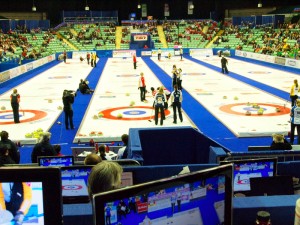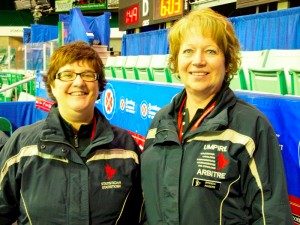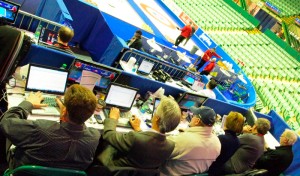Scotties Spotlight: View from the Media Bench
Row upon row of laptops and television screens, taking up prime real estate at the home end of the ice, the media bench is hard to miss. This bench is home to those behind the scenes people who make sure the game is played fairly, and that everyone at home can follow along.
Chief Umpire Brenda Rogers has been an umpire since 1986, and travels around the country to many Canadian Curling Association events. Before an event, Brenda puts together the on-ice schedule for the game umpires, and trains timers and local officials, who keep track of rock placement and update the on-ice scoreboards. She conducts the pre-event team meeting with all the coaches and curlers and also makes herself available to the teams forty-five minutes prior to game time to answer questions or deal with issues.
During the event, from the her vantage point on the media bench, she communicates with the timers, monitors all on-ice activities such as measures, and consults on issues and athlete appeals. After the draw is finished, she collects data from the other umpires and prepares a game report. She is also in charge of the last stone draw details, which determines which team has hammer for round robin and playoff games. Basically, what she says is final.
Brenda supervises a crew of five game umpires. Game umpires, situated one per sheet of ice during the action, assist players with rule interpretations, issues about rock placement and measurements from the button. They also monitor timeouts. The umpires work long days, arriving an hour before the morning draw and leaving late into the night after the last practice is finished. Brenda helps and supports her game umpires, and generally makes sure they are looked after.
Her favourite part of working these events is “The camaraderie. It’s great working with competitors, umpires, local officials and timers.” What makes a good umpire? Brenda suggests qualities such as a relaxed demeanour, authoritative but flexible manner, and enjoyment of working with people. She keeps coming back because “I do love it. I love the integrity of it and believe in the system. We help keep a level playing field. We make sure it’s fair for everybody out there.”
A few seats over from Brenda is Chief Statistician, Michelle Koebernick. One of only five Chief Statisticians in the country, she’s been keeping stats for the CCA for sixteen years – she started as a volunteer and got hooked. Now she guides a crew of about a dozen local volunteers. Though some of her volunteers have previous experience, many have never kept game statistics before.
During the game, one volunteer is assigned to watch one game, and scores both teams. They assess how the shot made compares to what was called, and score each shot out of 4. The volunteer also enter the scores after each end into Curlcast, the online scoring system, so people all over the world can follow the event. Michelle’s job is to train her volunteers, monitor the information going in and out to make sure the data is entered correctly and ensure the technology is working properly.
Michelle’s favourite part of working the events is “meeting new people, making lifelong friends with the volunteers and crew. And I get to sit on the media bench: it’s the best seat in the house!” She’s enjoying her time here at the Scotties so far, commenting “I love curling, and being here, working with the team. The curling has been good this week, and the crowd has been good too. That’s nice to see.”
Besides the umpire and statisticians, the media bench is mostly comprised of reporters from various local and national media outlets. Al Cameron, the curling writer for the Calgary Herald, has covered close to thirty major events. He has a passion for curling, remarking “I’ve got the two best beats: CFL and curling. The athletes are the most real people. They’re doing it for the love of the game. They have a passion for the sport and accept it’s not always going to go their way.”
To prepare for events, Al keeps up with other stories and news online, and reads up on the teams, though has been doing this long enough he already knows most of them. His days are spent watching, tweeting, and writing about curling – “There’s nothing like a deadline rush!” He notes the Scotties has a different feel than other curling events: “Women’s curling is interesting. It’s less predictable. It makes it frustrating and fascinating at the same time.”







